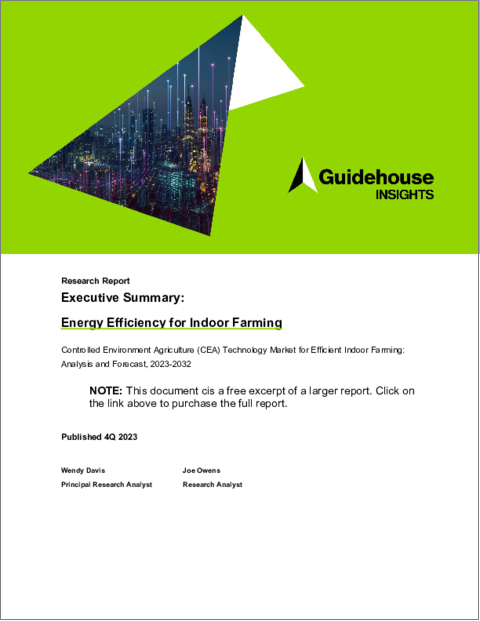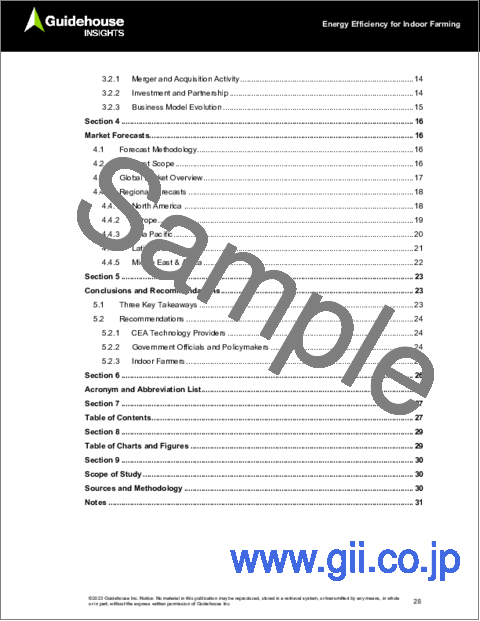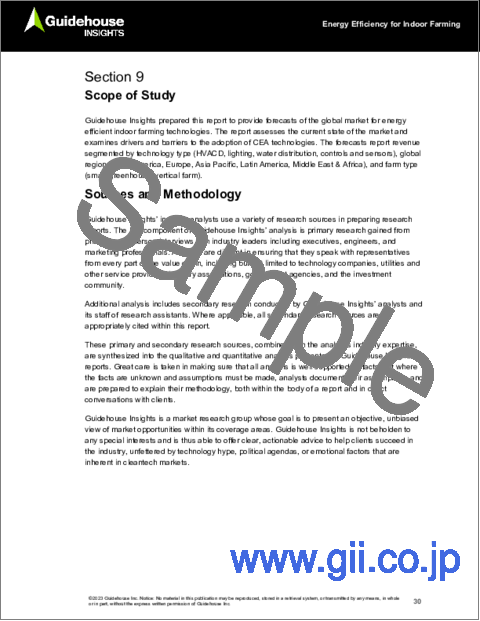|
|
市場調査レポート
商品コード
1389927
屋内農業のエネルギー効率Energy Efficiency for Indoor Farming - Controlled Environment Agriculture (CEA) Technology Market for Efficient Indoor Farming: Analysis and Forecast, 2023-2032 |
||||||
|
|||||||
| 屋内農業のエネルギー効率 |
|
出版日: 2023年12月04日
発行: Guidehouse Research
ページ情報: 英文 32 Pages; 29 Tables, Charts & Figures
納期: 即納可能
|
全表示
- 概要
- 目次
世界人口は2050年までに97億人を突破すると予測されており、国連食糧農業機関は、食糧需要が2012年の水準から50%増加すると見込んでいます。しかし、農業生産に利用できる土地の量は減少しており、自然災害や気候変動の影響により、2050年までに農作物の収穫量は12%減少すると予想されています。同時に、政府・投資家・企業は、より持続可能な生産を求めるようになっています。屋内農業に対するこうした長期的な促進要因は、高いエネルギーコストや人件費といった大きな障壁とぶつかり合っています。
こうした市場の力は、暖房・換気・空調・除湿 (HVACD)、補助照明、配水、自動化用センサー・制御を含む、効率的な制御環境農業 (CEA) 技術の重要性の舞台を設定します。屋内農場がこれらの技術をうまく活用できれば、エネルギーコストを削減し、持続可能な農業の将来において重要な役割を果たすことができます。
当レポートでは、世界の屋内農業向けエネルギー効率の技術・市場について分析し、技術の概略や市場の基本構造、主な市場促進・抑制要因、技術別 (HVACD、照明、配水、制御・センサー)・種類別 (スマート農業、垂直農業) および地域別の市場動向の見通しなどを調査しております。
目次
第1章 エグゼクティブサマリー
第2章 市場の問題
- 市場範囲
- 促進要因
- 人口増加と可耕地の不足
- 政府の支援・政策・基準・奨励金
- 屋内農業の利点
- 大麻の合法市場の拡大
- CEA (制御環境農業) 技術の進歩
- 抑制要因
- 高いエネルギーコストと技術コスト
- CEA技術に対する農家の理解不足
- 農村部の労働力・インフラ不足
第3章 業界のバリューチェーン
- 効率的な屋内農業
- 競合情勢
- 企業合併・買収 (M&A) 活動
- 投資とパートナーシップ
- ビジネスモデルの進化
第4章 市場予測
- 予測分析の手法
- 予測範囲
- 世界市場の概要
- 地域別の予測
- 北米
- 欧州
- アジア太平洋
- ラテンアメリカ
- 中東・アフリカ
第5章 結論・提言
- 3つの重要なポイント
- 推奨事項
- CEA技術のプロバイダー
- 政府関係者・政策立案者
- 屋内農業の農家
第6章 頭字語と略語のリスト
第7章 目次
第8章 図表
第9章 分析範囲
第10章 出典、方法論および注釈
The world population is projected to pass 9.7 billion by 2050, and the Food and Agriculture Organization of the United Nations expects food demand to increase by 50% from 2012 levels. However, the amount of land available for agricultural production is decreasing, and natural disasters along with other impacts of climate change are expected to decrease crop yields by 12% by 2050. At the same time, governments, investors, and corporations are increasingly demanding more sustainable production. These long-term drivers for indoor agriculture clash with major barriers such as high energy and labor costs.
These key market forces set the stage for the importance of efficient controlled environment agriculture (CEA) technologies, which include heating, ventilation, air conditioning, and dehumidification (HVACD); supplemental lighting; water distribution; and sensors and controls for automation. If indoor farms can successfully utilize these technologies, they can reduce energy costs and play a key role in the future of sustainable agriculture.
This Guidehouse Insights report examines market trends, drivers, and barriers for CEA technologies and includes forecasts across four technology segments (HVACD, lighting, water distribution, and controls and sensors) for both smart greenhouses and vertical farms. Forecast figures include regional segmentation of the world market.
Table of Contents
1. Executive Summary
- 1.1 Introduction
- 1.1.1 Market Drivers
- 1.1.2 Market Barriers
- 1.2 Global Market Outlook
2. Market Issues
- 2.1 Market Scope
- 2.2 Drivers
- 2.2.1 Population Growth and Lack of Arable Land
- 2.2.2 Government Support, Policies, Standards, and Incentives
- 2.2.3 Indoor Farming Benefits
- 2.2.3.1 Controlled Climate Conditions
- 2.2.3.2 Sustainability, Efficiency, and ESG Goals
- 2.2.4 Expansion of Legal Markets for Cannabis
- 2.2.5 Advances in CEA Technologies
- 2.2.5.1 HVACD
- 2.2.5.2 Lighting
- 2.2.5.3 Water Distribution
- 2.2.5.4 Automation Controls and Sensors
- 2.2.5.5 Growing Methods
- 2.3 Barriers
- 2.3.1 High Energy and Technology Costs
- 2.3.2 Farmers' Lack of Understanding around CEA Technologies
- 2.3.3 Insufficient Rural Workforce and Infrastructure
3. Industry Value Chain
- 3.1 Efficient Indoor Farming
- 3.2 Competitive Landscape
- 3.2.1 Merger and Acquisition Activity
- 3.2.2 Investment and Partnership
- 3.2.3 Business Model Evolution
4. Market Forecasts
- 4.1 Forecast Methodology
- 4.2 Forecast Scope
- 4.3 Global Market Overview
- 4.4 Regional Forecasts
- 4.4.1 North America
- 4.4.2 Europe
- 4.4.3 Asia Pacific
- 4.4.4 Latin America
- 4.4.5 Middle East & Africa
5. Conclusions and Recommendations
- 5.1 Three Key Takeaways
- 5.2 Recommendations
- 5.2.1 CEA Technology Providers
- 5.2.2 Government Officials and Policymakers
- 5.2.3 Indoor Farmers






